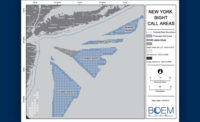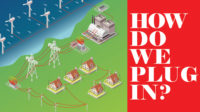Clean Energy Construction
Amazon, Google Buy 65% of Scotland Offshore Wind Project Power

Monopiles to support Moray West wind farm will weigh up to 2,000 tons and installed off Scotland in winter months for the first time, said its developer.
Image Courtesy: Moray West, Ocean Winds
Retail giant Amazon will purchase more than half of the output from an 882-MW, $3-billion offshore wind farm under construction off Scotland under a power purchase agreement signed Jan. 30 with Ocean Winds, a joint venture developer led by utility firm ENGIE. The deal follows a 100-MW power agreement the Moray West project reached with Google in 2022—for a total of 65% of project energy generated to be bought by the U.S.-based technology firms.
UPDATE: Google announced Feb. 1 it has signed deals for 700 MW of added offshore wind—including 478MW from North Sea projects off the Dutch coast being built by Shell and utility Eneco, a Mitsubishi unit, and the remainder from sources in Belgium, Italy and Poland. These would be the firm's largest clean energy purchase.
The Dutch projects are the 759-MW, 69 turbine HKN farm about 18 kilometers offshore that recently began operation and the 54-turbine HKW project being built about 53 km offshore and set to generate about 1.4GW by 2026.
Google also is set to reach a long-term supply agreement with an Italian energy company's 47-MW onshore wind energy project. “Our ambition to operate on carbon-free energy around the clock by 2030 requires clean energy solutions in every grid where we operate,” said Matt Brittin, president of its Europe, Middle East and Africa region.
The U.K. Ocean Winds project, which also includes utility firm EDP Renewables, is set to come on line late this year or in early 2025. Accelerated construction began last fall. In comments to publication Recharge, project CEO Bautista Rodriguez termed the Amazon agreement “an innovative and unprecedented route to market for an offshore wind farm.” He said its power delivery plan is “ambitious” but also has corporate and client support that will keep the project “firmly” on its fast track.
The company did not elaborate on its fast-track approach other than to say it would enter into a relatively small number of large contracts for different aspects of the project.
“There is a fantastic team working on the project and my role is to get the best from them, provide guidance and support to ensure the intricate four-dimensional jigsaw safely comes together in the right sequence,” project director Pete Geddes said.
World Record Turbines Planned
Turbine maker Siemens Gamesa has the contract to produce and install 60 large 14.7-MW wind turbines—for the first time globally. They would be the largest installed on a non-Chinese offshore wind facility.
Manufacture of the first 108-m-long turbine blade finished in December, with the firm set to produce a total of 180 blades. “With each blade slightly longer than an international football pitch, the scale of the engineering is impressive,” Adam Morrison, Ocean Winds UK manager said.
Other contractors include Belgium-based DEME, which began installing turbine monopiles last October that it expects to complete in early spring. “In an industry breakthrough, this challenging project will be the first time extra-large monopiles weighing up to 2,000 tons will be installed in the winter period,” the company said. It said it will deploy its double-staged, motion compensated pile gripper and a vibro-hammer, also for the first time, to overcome weaker soil layers, also performing bolting and grouting work for monopile-turbine connections.The monopiles will each be 10.5-m in diameter and 100-m long.
Monopiles are being manufactured in China since last year, and also in Spain.
Contractor Boskalis, based in the Netherlands, is using a 4,000-ton crane and a new upending hinge and motion-compensated pile gripper also for monopile installation at Moray West. The firm also is installing two substations designed by Siemens Energy at the site.
Neither DEME nor Boskalis disclosed the value of their contracts for Moray West, but termed them “sizable,” ranging between $63 million and $190 million.
Installation of transition pieces were set to begin Jan. 23 with expected completion in June.
European contractor Nexans has been handling design, manufacture and installation of onshore and offshore export cable systems for the project since December 2021. Fugro GB Marine and Scotland-based Vysus Group have a contract for geotechnical site investigations.
Amazon Pushes Clean Energy By 2025
Lindsay McQuade, Amazon director of energy, said projects like Moray West will play a critical role in decarbonizing company operations. The retailer is on track to meet its goal of power global operation with 100% renewable energy by 2025, five years earlier than a previous goal, she said.
Amazon is the largest renewable energy purchaser in Europe and the U.K., Ocean Winds said.
The developers' 950-MW Moray East offshore wind farm opened in 2018.
Power purchase deals are a route to support large offshore projects outside government contracts, while allowing energy intensive companies to achieve climate targets, said a board member at German energy company EnBW after steelmaker Salzgitter Group, Europe's largest producer, committed to buy 50 MW of output from its 960-MW He Dreiht offshore wind project off Germany.
Agreements are expected to grow exponentially, rising 25% by 2030, say consultant Pexapark and German energy agency Dena.
In March 2023. Amazon also signed a supply deal with Iberdrola to support large scale energy projects, including two Baltic Sea offshore wind farms—the 476-MW Baltic Eagle and the 300-MW Windanker, both under construction. “It is a long-term agreement to supply Amazon with 1,000 GWh of green energy” from the Baltic Sea projects, Ignacio Galan, Iberdrola executive chairman, said.
Big U.S. Project to Start At-Sea Construction
Related to U.S. offshore wind project development, investor-owned utility firm Dominion Energy said Jan. 30 it received the last two federal approvals to start at-sea building work in the second quarter on its planned 2.6-GW, $9.8 billion Coastal Virginia Offshore Wind project, which is set to operate in late 2026.
When complete, it would be America's largest offshore wind energy project—with 176 turbines, each producing 14.7 MW of energy and manufactured by Siemens Gamesa—as well as turbine monopile foundations, three substations and related infrastructure.
The project, which is sited about 27 miles off the coast of Virginia Beach, received final approvals from the U.S. Interior Dept. for its construction and operations plan (COP) and from the U.S. Army Corps of Engineers for export cable installation for power transmission to the onshore grid.






